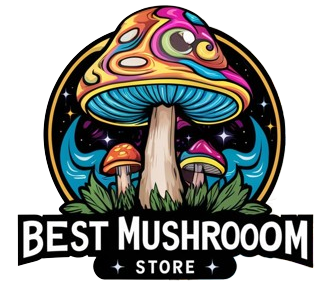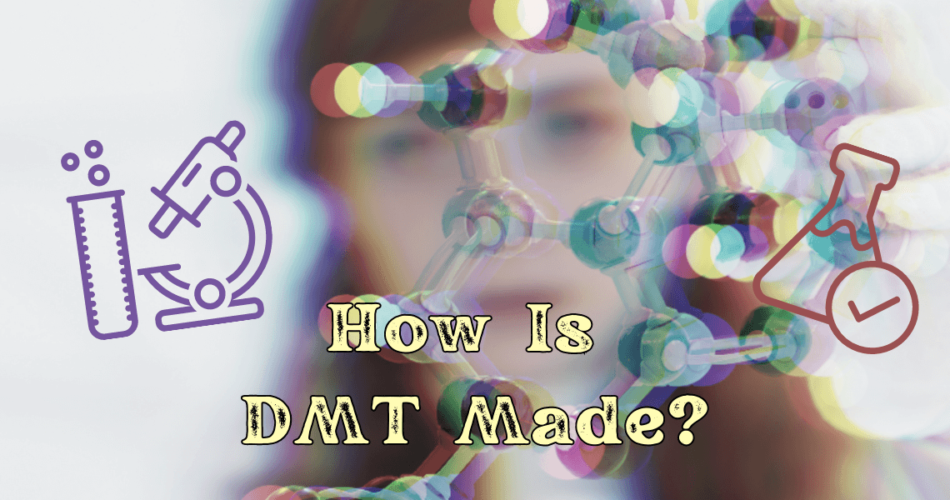DMT, or dimethyltryptamine, is naturally found in plants. It’s a rapidly working but short-duration psychedelic drug, and has been used for centuries in cultural and shamanic practices. But how is DMT made? If you’re curious about the chemistry behind it, keep reading!
TL;DR
- DMT is either extracted from natural plant sources (like Mimosa) or synthesized in the lab 🧪
- The synthetic version of DMT is pure, and thus has more predictable effects. Products of extractions that psychedelic enthusiasts like to attempt at home can be dangerous ⚠️
What Is DMT? Is It the Same As Ayahuasca?
DMT is a powerful hallucinogenic drug that occurs naturally in certain plants, including Mimosa tenuiflora, Diplopterys cabrerana and Psychotria viridis. It has a similar structure to serotonin and melatonin, two compounds naturally produced in the human brain. Some of its forms, like 5-MeO-DMT, are natural metabolites released by the pineal gland.

In its pure form, DMT is usually synthesized in a laboratory setting as a white crystalline powder. Ayahuasca, on the other hand, is a traditional Amazonian brew with DMT as its main active ingredient. How is DMT made in this form?
How Is Ayahuasca Prepared?
It’s made by boiling together the ayahuasca vine (Banisteriopsis caapi) and the leaves of one or more plants that contain DMT. The combination creates a powerful and long-lasting psychedelic experience, used in traditional spiritual and healing practices.
While ayahuasca contains DMT, they aren’t exactly the same thing. The psychoactive effects of DMT (smoked, inhaled or injected in its pure form) only last for 5–15 minutes. Thanks to other active ingredients in the brew (monoamine oxidase inhibitors, or MAOIs), the effects of ayahuasca tend to last much longer – 3 hours or more.
How Is DMT Made? Methods
Without a natural source of DMT, the steps involved in synthesizing it may include:
- Starting with a precursor compound such as tryptamine, which can be derived from the amino acid tryptophan.
- Using chemical reactions to convert the tryptamine into DMT. This typically means adding methyl groups (CH3) to the amino groups (NH2) of the tryptamine molecules. Formaldehyde and sodium cyanoborohydride are two frequently used chemicals.
- Purifying the product using various techniques, such as column chromatography or recrystallization, to remove any impurities and isolate the pure DMT molecule.
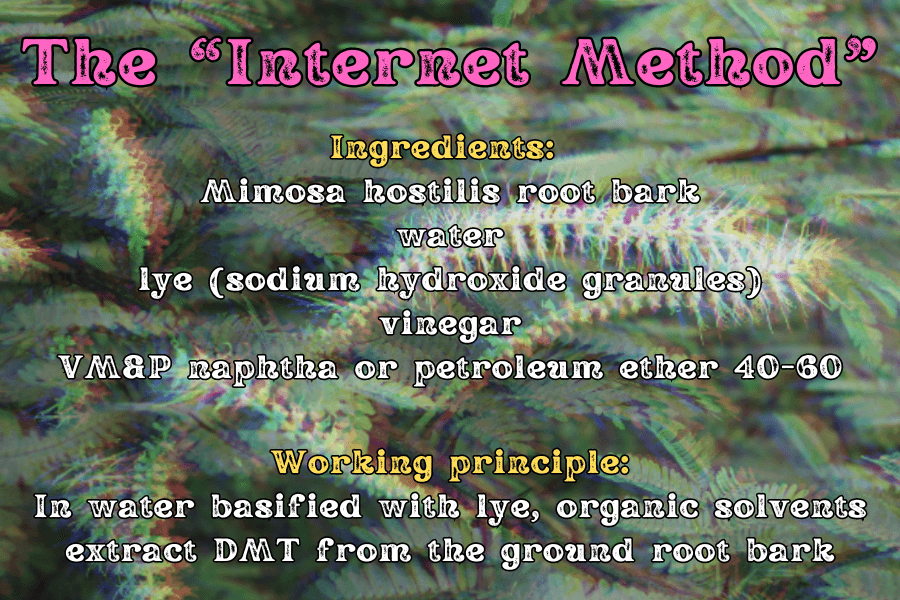
How is DMT made without tryptamine? Another synthetic route starts with the reaction of indole with oxalyl chloride. The product then reacts with dimethylamine, followed by lithium aluminum hydride to form DMT – an indole alkaloid. It’s complex chemistry, so we aren’t going to delve deep into it here.
Anyway, the synthesis of DMT is illegal in many countries, including the United States, and can carry significant legal penalties. Additionally, DMT may be extremely potent and should only be used under the supervision of a knowledgeable and experienced practitioner.
Is It Possible to Extract DMT at Home?
If you’re wondering whether DMT can be extracted at home, you’ve probably heard about DMT users extracting it from the Mimosa hostilis plant species. According to a scientific study, it’s indeed possible, but the end product is impure. It’s hard to tell what else is in there besides the hallucinogenic tryptamine drug. People who use synthetic DMT experience a similar high, but it’s important to note that the organic solvents used in the extraction (such as n-hexane and chloroform) can be dangerous to human health.
Harm Reduction When Using DMT
Knowing the answer to “How is DMT made?”, some people might want to attempt producing and using it at home. Harm reduction measures are similar to those that LSD and psilocybin users employ:
- Before taking any hallucinogen, make sure you’re in a safe and controlled environment.
- Educate yourself about the interactions between DMT and any medication you’re taking.
- Whether it’s DMT or classic psychedelics, don’t use them without a sober person present to help you in case anything bad happens.
- Keep in mind that hallucinations can return in the form of flashbacks.
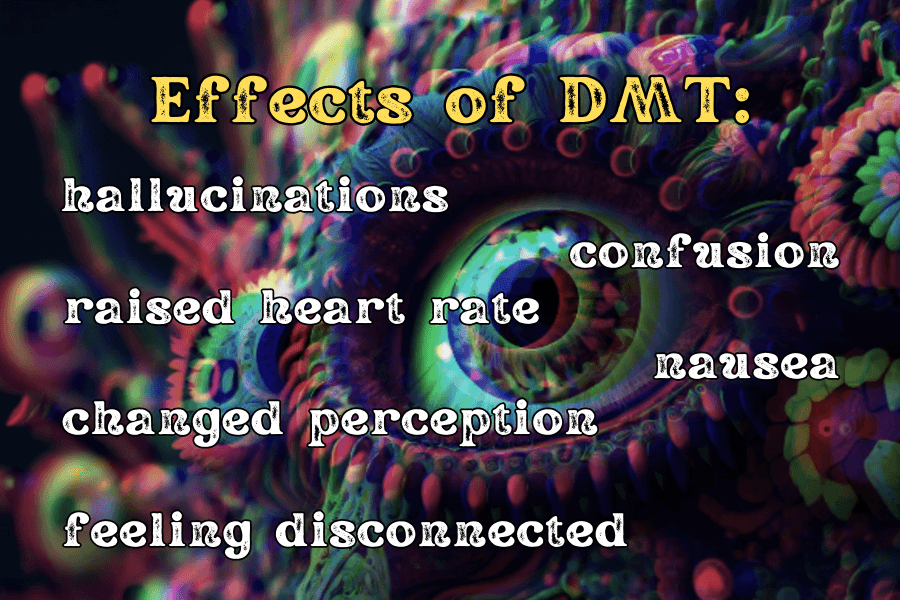
Messing With Neurotransmitters: Serotonin Syndrome ⚠️
If you’re taking antidepressants, the hallucinogenic effects of DMT could come with a high price: serotonin syndrome. Some people on South American retreats have been affected by it after taking ayahuasca to induce a spiritual experience. DMT powder is even more potent, and it can even be life-threatening to people who take regular medication for their mental health conditions.
Frequently Asked Questions
How Did They Discover DMT?
Naturally occurring DMT has been used in South America since pre-Columbian times. The chemical was first extracted from the root bark of the jurema preta plant (Mimosa tenuiflora) in 1946 and named nigerine, but it wasn’t a pure form of DMT – it had an additional oxygen atom. What we know as DMT was later isolated from seeds and pods of yopo (Anadenanthera peregrina) and formally identified in 1955. Since then, it has been found in other plants and animals, including humans.
What Is the Chemical Formula for DMT?
The empirical formula is C12H16N2. It doesn’t tell us anything about the shape of the molecule, though. For that, refer to the image below.
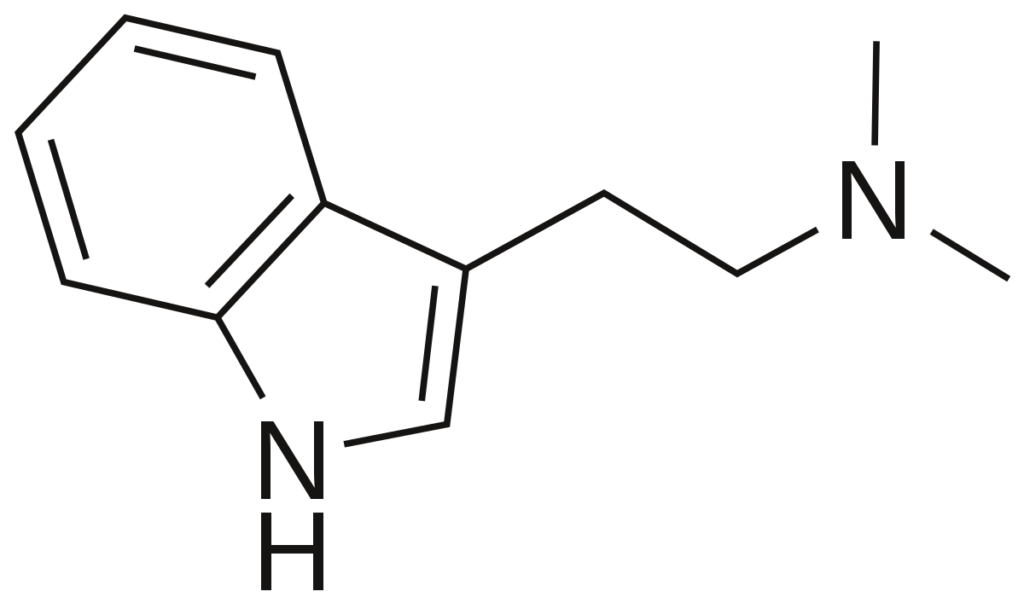
How Do You Pronounce DMT?
You can either say DMT (dee-em-tee) or dimethyltryptamine (die-meth-uhl-trip-tuh-meen).
What Elements Are in DMT?
DMT contains carbon, hydrogen and nitrogen. It has a similar structure to tryptamine, but instead of its two hydrogen atoms (H) on the terminal nitrogen of the ethylamine side chain, there are two methyl (CH3) groups.
Is DMT a Polymer?
There is a polymer made of “DMT,” but it’s not the same as the hallucinogen DMT. The polymer compound’s full name is dimethyl terephthalate, and its chemical formula is C6H4(COOCH3)2. From this, polyesters like polyethylene terephthalate (PET), polytrimethylene terephthalate (PTT), and polybutylene terephthalate (PBT) are made.
Similar Posts:
- DMT Natural Sources: DMT-Containing Plants and Their Levels of N-Dimethyltryptamine
- DMT vs LSD: What Do We Know About These Two Psychedelic Substances?
- How Long Does a DMT Trip Last and Can You Make It Longer?
- Can You Sleep on LSD? Tryptamine and the Effects of LSD on Your Sleep Cycle
- What Does LSD Taste Like? “If It’s Bitter, It’s a Spitter!”
- Types of Psychedelics: Hallucinogen Drugs Facts, From LSD to Psilocybin
- Ayahuasca vs DMT: Are These Psychedelics the Same?
